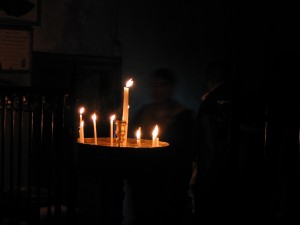
Many years ago my spouse and I took a vacation in the Ozarks during an unusually warm spell in late December. One day, since it was so mild, we decided to go canoeing. We located a canoe rental place and one of the employees loaded the canoe in his truck and drove us up river.
Just as he was dropping us off, he told us that nobody had canoed down since the severe floods that had come through earlier that year, so there might be debris in the river. His warning made me uneasy because, although my husband had experience canoeing, it was my first time.
We got our canoe into the water–I managed to climb in without tipping it over–and once we set out my anxiety began to lift. It was a gorgeous day and I was enjoying paddling along with the gentle current. We came on a few mild rapids that made the ride a bit more exciting, but for the most part the river was tranquil.
We came to a bend in the river where it forked around a small island. Because the riverbank obstructed our view of the left fork and the island obstructed our view of the right we couldn’t see which side was the better to take, so we just took a chance and steered to the left.
Just as we came around the bend, we saw that there was a fallen tree blocking most of the channel. We both started paddling as hard as we could to get the canoe far enough over to the right to clear the tree, and for a moment it looked like we were going to make it. The bow and I cleared the snag but the back of the canoe didn’t. A branch caught my husband in the chest, and we capsized.
We grabbed the canoe and were dragging it toward the island when I saw that my backpack was floating away. I reached out to grab it. The current caught me and started carrying me downstream.
I tried as hard as I could to swim to the shore, but the current was too strong. Even though it was a mild day, it was December and the frigid water saturated my jeans, my parka, my shoes. It flowed beneath my clothing, against my bare skin. I was frantic. As the river carried me further and further downstream, I knew there was a very real possibility I could die.
I couldn’t fight the current. It was simply stronger than I was. So eventually I did the only thing I could do. I let the river have me. I surrendered.
Just as I surrendered, the most profound peace came over me. I was awestruck at the beauty surrounding me–the rolling landscape, the bare trees, the blue sky, the music of the water lapping against my body. “I might die,”I thought, “but this is so beautiful!”
It was a moment of revelation for me. My circumstances were just as dire as they had been a moment before, but by surrendering to them my panic had instantly shifted into a profound peace.
Eventually there was a piece of land jutting out into the river that I managed to grab hold of and I was able to climb ashore, and though what happened next is a story unto itself, with its own lesson that perhaps I’ll tell about some other time, for now I am letting myself revisit the deep peace that came upon me in that moment of complete surrender.
As I look back over my life I can safely say that the most significant spiritual moments I have ever had have not come as a result of my striving, but as a result of my surrendering. It makes me wonder if people in our society often feel spiritually unfulfilled because surrender is not something we are taught to do. We idolize the fighters and disdain the “quitters.” But there are times when quitting is the only sane choice.
Buddhists call this surrender to what is non-resistance. The Tao te Ching speaks of it as yielding. Jesus spoke of it as giving oneself over to the divine will. This willingness to let go–so terrifying to the ego–is at the heart of all spiritual life.
Christian theologian Reinhold Niebuhr wrote the prayer which was made famous by Alcoholics Anonymous. Known as the Serenity Prayer, the first four lines are the most familiar:
God grant me the serenity
to accept the things I cannot change;
courage to change the things I can;
and wisdom to know the difference.
I appreciate the insight in Niebuhr’s prayer because it articulates the dance we do as humans. Sometimes we need to do what is required to correct circumstances that need correcting. But oftentimes the harder thing is to surrender to that which is.
In my experience though, it isn’t serenity that makes me able to accept the things that I cannot change. Serenity is what comes when I do.





